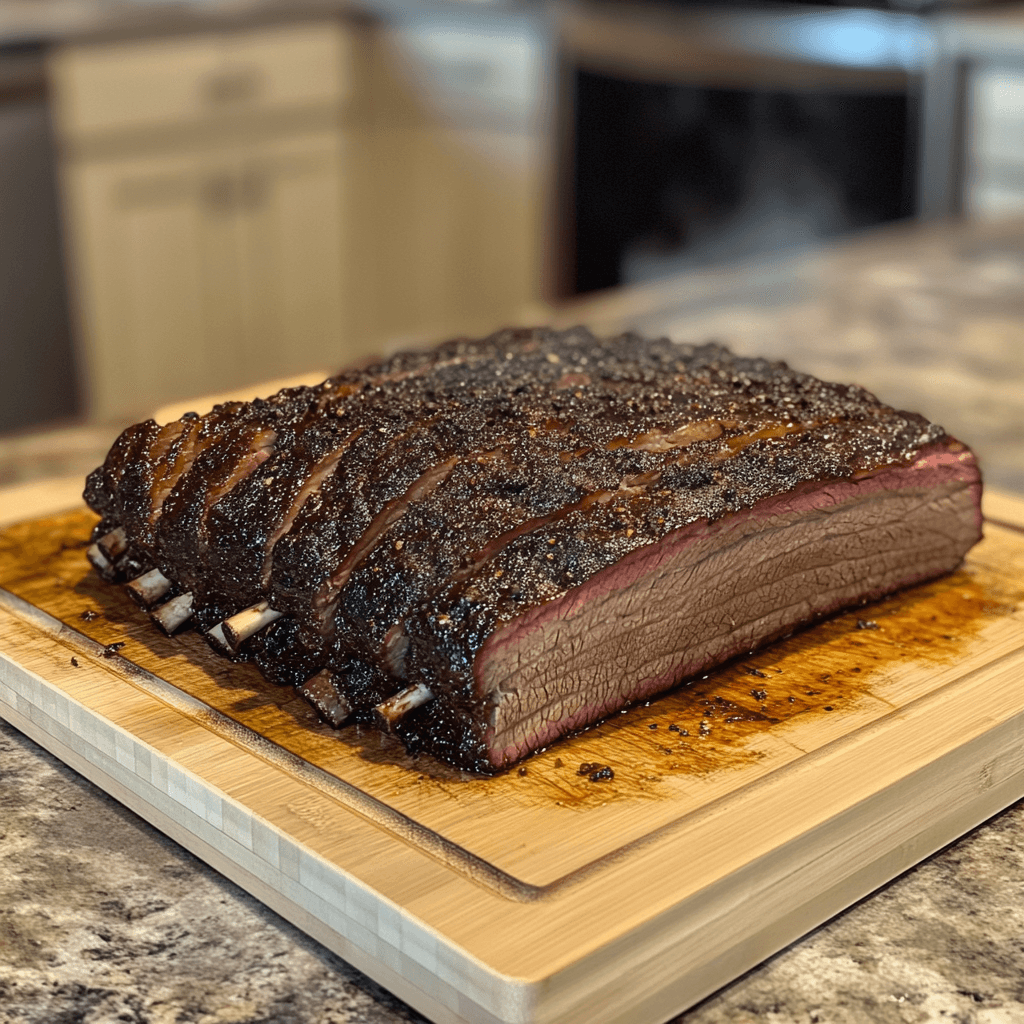Smoking brisket is a craft, and mastering the perfect method can feel like finding a secret recipe. Whether you’re a BBQ newbie or a seasoned pitmaster, the 3/2-1 method has likely caught your eye. It’s a time-tested technique known for delivering tender, flavorful results with ease. In this article, we’ll break down exactly what the 3/2-1 method for brisket is, why it’s a favorite among enthusiasts, and how to execute it flawlessly. Along the way, you’ll discover tips, tools, and even how this method compares to other smoking techniques. Let’s fire up the smoker and dive in!
Introduction to the 3/2-1 Method
What Does the 3/2-1 Method Entail?
The 3/2-1 method is a step-by-step approach to smoking brisket that ensures consistent results. It’s named after the time allocation: three hours of smoking, two hours of wrapping, and one hour of finishing unwrapped. The method was originally designed for ribs but works exceptionally well for brisket. By dividing the cooking process, it balances flavor, moisture, and texture to create a brisket that’s tender yet packed with smoky goodness.
Historical Context of Smoking Techniques
Smoking meat dates back centuries, originating as a preservation method before evolving into a beloved culinary art. The low-and-slow cooking process central to smoking allows tough cuts like brisket to break down their connective tissues, resulting in mouthwatering tenderness. The 3/2-1 method emerged as a modern twist, combining tradition with a structured formula for fail-proof cooking.
Why Choose the 3/2-1 Method for Brisket?
What sets this method apart is its simplicity and reliability. Even beginners can achieve professional-grade results. The wrapping stage, for instance, locks in juices, ensuring your brisket doesn’t dry out. Plus, it creates a robust bark—that delicious, smoky crust on the outside of the meat. Whether you’re impressing guests or just treating yourself, the 3/2-1 method guarantees success every time.
Step-by-Step Breakdown of the 3/2-1 Method
The “3” in the Method: Smoking Brisket for Three Hours
The first phase of the 3/2-1 method sets the foundation for flavor. During these three hours, the brisket absorbs that signature smoky aroma. Start by preheating your smoker to 225°F—a sweet spot for low-and-slow cooking. Select wood chips that complement brisket’s rich taste, such as hickory, oak, or mesquite.
Place your seasoned brisket directly on the smoker grate, fat side up, to allow the fat to render down and keep the meat moist. During this stage, resist the urge to peek too often. Opening the smoker lets out heat and smoke, which can throw off cooking times. Use a reliable meat thermometer to monitor internal temperatures.
By the end of this stage, the brisket should develop a nice smoky exterior without fully cooking through. The smoky bark, which enhances texture and flavor, begins forming here.
The “2” in the Method: Wrapping Brisket for Two Hours
Next, it’s time to lock in the juices. Wrapping the brisket for two hours creates a mini steam environment that tenderizes the meat. Use either aluminum foil or butcher paper, depending on your preference. Foil seals in moisture better, while butcher paper allows the brisket to breathe, preserving some of the bark’s crispness.
Before wrapping, consider spritzing the brisket with a mix of apple cider vinegar or beef broth to enhance its flavor and maintain moisture. Wrap the brisket tightly to prevent steam from escaping and return it to the smoker.
During this stage, the internal temperature of the brisket climbs into the stall—a phase where the meat’s temperature plateaus. Wrapping accelerates this process, ensuring the brisket pushes through to tender perfection.
The “1” in the Method: Unwrapping and Finalizing for One Hour
Finally, unwrap the brisket for the last hour to give the bark a chance to firm up. At this point, the internal temperature should be around 195–203°F—ideal for tender, sliceable brisket. Return the brisket to the smoker unwrapped, allowing the heat to finish the cooking process while intensifying the smoky crust.
Once it’s done, remove the brisket from the smoker and let it rest for 30–60 minutes. This step ensures the juices redistribute, so every bite is as flavorful as possible. Slice against the grain for maximum tenderness and serve up your masterpiece.
Benefits and Challenges of the 3/2-1 Method
Why It’s a Popular Choice Among BBQ Enthusiasts
The 3/2-1 method has gained fame for a reason: it delivers consistent, high-quality results. Its structured timeline removes much of the guesswork that comes with smoking brisket, making it a favorite for beginners and pros alike. The wrapping stage ensures the meat stays juicy, while the unwrapping phase enhances that irresistible bark.
Additionally, this method allows for customization. Want a smokier flavor? Experiment with different wood chips during the first three hours. Prefer a spicier crust? Tweak your dry rub ingredients. The flexibility of the 3/2-1 method means you can tailor it to suit your taste buds.
Common Pitfalls to Avoid
Despite its advantages, the 3/2-1 method isn’t without its challenges. One common issue is over-smoking during the initial three hours. Too much smoke can lead to a bitter aftertaste, so it’s crucial to maintain a steady flow of clean, blue smoke—not thick, white plumes.
Another mistake is wrapping too loosely. If the brisket isn’t sealed properly during the wrapping stage, steam escapes, and the meat may dry out. Lastly, keep an eye on your smoker’s temperature. Fluctuations can affect cooking times and lead to uneven results.
By paying attention to these details, you can avoid common pitfalls and make every brisket a success.
Comparison with Other Smoking Techniques
Traditional Smoking vs. the 3/2-1 Method
When comparing what the 3/2-1 method for brisket offers against traditional smoking methods, the difference lies in precision. Traditional smoking focuses purely on “low and slow” cooking, often requiring constant monitoring and adjustments. The 3/2-1 method, however, structures the process into manageable stages, reducing the need for hands-on oversight.
Traditional smoking allows for a deeper smoke penetration but can result in uneven cooking if not handled carefully. On the other hand, the wrapping stage in the 3/2-1 method helps brisket push through the infamous stall phase, ensuring tender results. For beginners, this method is less intimidating while still delivering mouthwatering brisket.
Quick Smoking Techniques: Pros and Cons
Quick smoking methods, like high-temperature smoking, aim to cut cooking time in half. While this might appeal to those short on time, the risks are clear: the brisket may dry out or miss out on developing a rich, smoky flavor. The 3/2-1 method, with its gradual stages, avoids these pitfalls while balancing flavor and tenderness.
Reverse Sear vs. the 3/2-1 Method
The reverse sear method, often used for steaks, focuses on finishing meat with high heat for a crispy crust. While this approach adds a unique texture to smaller cuts, it may not provide the same tenderness or deep smokiness the 3/2-1 method for brisket achieves. For those prioritizing juicy, smoky brisket, the 3/2-1 approach remains unbeaten.
For more brisket tips and tricks, check out our guide on tender brisket preparation.
Essential Tools and Ingredients for the 3/2-1 Method
Must-Have Equipment for Smoking Brisket
To perfect the 3/2-1 method, you’ll need some essential tools. A reliable smoker—whether pellet, charcoal, or electric—is key. Pair it with a meat thermometer to monitor internal temperatures. Additionally, tongs and heat-resistant gloves make handling hot brisket much safer.
A water pan is another great addition to maintain moisture during the cooking process. Don’t forget the wood chips! Hickory, oak, or pecan are ideal for brisket, creating a balanced smoky flavor.
Choosing the Right Cut of Brisket
The choice between flat cut and point cut can make or break your brisket. The flat cut, leaner and uniform in shape, is perfect for the 3/2-1 method, ensuring even cooking. Meanwhile, the point cut, with its higher fat content, offers richer flavor but requires more attention to prevent overcooking.
When shopping, look for brisket with a thick fat cap. This layer protects the meat during smoking, contributing to a juicier final product.
Perfect Seasoning Rubs and Marinades
A flavorful seasoning rub elevates your brisket from good to extraordinary. Classic rubs often include salt, black pepper, paprika, and garlic powder. Add cayenne for heat or brown sugar for a touch of sweetness.
For marinades, consider a mix of apple cider vinegar, Worcestershire sauce, and beef broth. Marinating overnight deepens the flavor, ensuring every bite is rich and savory.
For a creative twist on brisket, try pairing it with our brisket mac and cheese recipe.
FAQs About the 3/2-1 Method
Does the 3/2-1 Method Work for All Cuts of Meat?
While the 3/2-1 method shines with brisket, it’s a versatile technique that can be adapted for other cuts, especially ribs. However, for smaller, leaner cuts like chicken breasts or pork tenderloin, the timing may need adjustments to prevent overcooking. For those new to smoking, brisket remains the ideal starting point, as its higher fat content benefits greatly from this method.
What is the Ideal Temperature for Smoking Brisket?
The perfect smoking temperature for brisket, especially when using the 3/2-1 method, is a consistent 225°F. This low and steady heat allows the connective tissue to break down gradually, ensuring a tender, juicy result. Make sure to monitor your smoker closely to avoid fluctuations, which could affect the final texture.
Can I Use an Electric Smoker for the 3/2-1 Method?
Absolutely! Electric smokers are excellent for maintaining consistent temperatures, making them a great option for the 3/2-1 method. Their user-friendly design is perfect for beginners. Just be sure to choose wood chips that match your flavor preferences, such as mesquite or applewood, to enhance the brisket’s smoky taste.
How Do I Achieve a Juicy Brisket Every Time?
A juicy brisket comes down to preparation and technique. Start with a quality cut of meat, apply a flavorful rub, and follow the 3/2-1 method to balance moisture and tenderness. Wrapping during the second stage traps in steam, while resting the brisket after cooking redistributes its juices. For extra flavor, spritz your brisket with apple cider vinegar during the first stage of smoking.
Tips and Tricks for Perfecting the 3/2-1 Method
Customizing the Method to Your Taste
One of the best parts of the 3/2-1 method for brisket is its flexibility. If you prefer a more pronounced smoky flavor, you can extend the initial smoking stage to four hours. For those who love a spicier bark, try adding chili powder or cayenne pepper to your rub. Even the wrapping stage can be personalized—swap out plain foil for butcher paper to preserve more of the bark’s crunch.
Experimenting with Different Woods and Flavors
Wood choice plays a huge role in the overall flavor of your brisket. Hickory and oak are classic options, providing a rich, robust taste. For a sweeter, milder profile, consider using applewood or cherry. Mixing woods is another way to experiment with unique flavors. For instance, blending pecan and mesquite adds a balance of nuttiness and bold smokiness.
Pro Tips from Pitmasters
Pitmasters agree: patience is key. Rushing the process by increasing the smoker’s heat can lead to a dry, tough brisket. Another insider tip is to keep a water pan in the smoker to maintain humidity, which helps the brisket stay moist. Lastly, always rest your brisket for at least 30 minutes after smoking to allow the juices to redistribute evenly.
By mastering these techniques and tailoring them to your preferences, you’ll soon be producing brisket that rivals the pros. Whether you’re a BBQ enthusiast or just exploring new recipes, the 3/2-1 method for brisket is sure to impress every time.
For more barbecue inspiration, explore additional recipes on Yearly Recipes.

